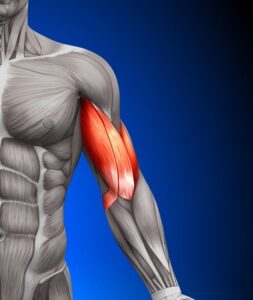BICEPS TENDINITIS
If you suffer from pain or weakness in the arm, please Schedule an appointment with one of our orthopedic specialists as soon as possible.
 What is Biceps Tendinitis?
What is Biceps Tendinitis?
Orthopedic specialists define Biceps tendonitis as an inflammation in the upper biceps tendon. This upper biceps tendon helps connect the biceps muscle to the shoulder socket and stabilizes the joint.
In late stages of biceps tendonitis, inflammation causes the tendon to turn a dark red color. Sometimes tendon damage can cause the tendon to tear, whether partially or completely. A complete tear will cause the arm to deform, leading to a “Popeye” bulge in the arm.
Overuse conditions such as Biceps Tendonitis can arise from any repetitive job or activity over a long enough period of time. Athletes who participate in baseball, swimming, tennis, or other sports that accentuate repetitive overhead arm motion, have a higher risk of developing Biceps Tendinitis.
Symptoms of Biceps Tendinitis include pain and weakness in the front of the shoulder. Symptoms often resolve with simple rest and medication. Only severe cases of Biceps Tendinitis will require surgical intervention by an orthopedic specialist.
Biceps Tendinitis Procedure
Biceps Tendinitis Procedure Benefits
The procedure to treat biceps tendinitis offers several benefits for individuals experiencing this painful condition. Primarily, it aims to relieve chronic pain and inflammation in the biceps tendon, which significantly improves overall shoulder function and daily comfort. By addressing the root cause of the inflammation, the procedure helps restore normal tendon health and reduces the risk of recurrent issues.
Another significant benefit is the improvement in shoulder strength and range of motion. Patients often experience difficulty with lifting, reaching, and other movements due to tendinitis, and surgical intervention can effectively restore these capabilities. Enhanced mobility and strength allow individuals to return to their regular activities and sports with greater ease and confidence.
Furthermore, the procedure helps prevent further tendon damage and degeneration, thereby preserving the long-term health of the shoulder joint. This proactive approach ensures sustained relief and functional improvement, contributing to an overall better quality of life for patients with biceps tendinitis.
Biceps Tendinitis Recovery

 What is Biceps Tendinitis?
What is Biceps Tendinitis?